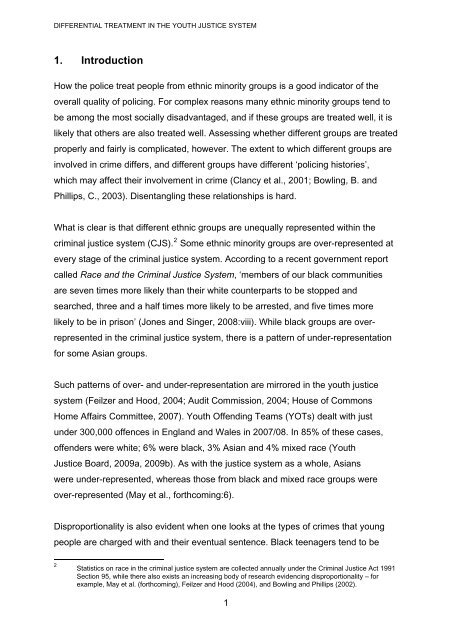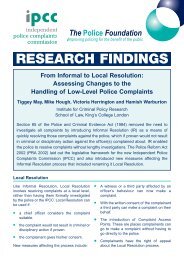Differential treatment in the youth justice system - Equality and ...
Differential treatment in the youth justice system - Equality and ...
Differential treatment in the youth justice system - Equality and ...
Create successful ePaper yourself
Turn your PDF publications into a flip-book with our unique Google optimized e-Paper software.
DIFFERENTIAL TREATMENT IN THE YOUTH JUSTICE SYSTEM1. IntroductionHow <strong>the</strong> police treat people from ethnic m<strong>in</strong>ority groups is a good <strong>in</strong>dicator of <strong>the</strong>overall quality of polic<strong>in</strong>g. For complex reasons many ethnic m<strong>in</strong>ority groups tend tobe among <strong>the</strong> most socially disadvantaged, <strong>and</strong> if <strong>the</strong>se groups are treated well, it islikely that o<strong>the</strong>rs are also treated well. Assess<strong>in</strong>g whe<strong>the</strong>r different groups are treatedproperly <strong>and</strong> fairly is complicated, however. The extent to which different groups are<strong>in</strong>volved <strong>in</strong> crime differs, <strong>and</strong> different groups have different ‘polic<strong>in</strong>g histories’,which may affect <strong>the</strong>ir <strong>in</strong>volvement <strong>in</strong> crime (Clancy et al., 2001; Bowl<strong>in</strong>g, B. <strong>and</strong>Phillips, C., 2003). Disentangl<strong>in</strong>g <strong>the</strong>se relationships is hard.What is clear is that different ethnic groups are unequally represented with<strong>in</strong> <strong>the</strong>crim<strong>in</strong>al <strong>justice</strong> <strong>system</strong> (CJS). 2 Some ethnic m<strong>in</strong>ority groups are over-represented atevery stage of <strong>the</strong> crim<strong>in</strong>al <strong>justice</strong> <strong>system</strong>. Accord<strong>in</strong>g to a recent government reportcalled Race <strong>and</strong> <strong>the</strong> Crim<strong>in</strong>al Justice System, ‘members of our black communitiesare seven times more likely than <strong>the</strong>ir white counterparts to be stopped <strong>and</strong>searched, three <strong>and</strong> a half times more likely to be arrested, <strong>and</strong> five times morelikely to be <strong>in</strong> prison’ (Jones <strong>and</strong> S<strong>in</strong>ger, 2008:viii). While black groups are overrepresented<strong>in</strong> <strong>the</strong> crim<strong>in</strong>al <strong>justice</strong> <strong>system</strong>, <strong>the</strong>re is a pattern of under-representationfor some Asian groups.Such patterns of over- <strong>and</strong> under-representation are mirrored <strong>in</strong> <strong>the</strong> <strong>youth</strong> <strong>justice</strong><strong>system</strong> (Feilzer <strong>and</strong> Hood, 2004; Audit Commission, 2004; House of CommonsHome Affairs Committee, 2007). Youth Offend<strong>in</strong>g Teams (YOTs) dealt with justunder 300,000 offences <strong>in</strong> Engl<strong>and</strong> <strong>and</strong> Wales <strong>in</strong> 2007/08. In 85% of <strong>the</strong>se cases,offenders were white; 6% were black, 3% Asian <strong>and</strong> 4% mixed race (YouthJustice Board, 2009a, 2009b). As with <strong>the</strong> <strong>justice</strong> <strong>system</strong> as a whole, Asianswere under-represented, whereas those from black <strong>and</strong> mixed race groups wereover-represented (May et al., forthcom<strong>in</strong>g:6).Disproportionality is also evident when one looks at <strong>the</strong> types of crimes that youngpeople are charged with <strong>and</strong> <strong>the</strong>ir eventual sentence. Black teenagers tend to be2Statistics on race <strong>in</strong> <strong>the</strong> crim<strong>in</strong>al <strong>justice</strong> <strong>system</strong> are collected annually under <strong>the</strong> Crim<strong>in</strong>al Justice Act 1991Section 95, while <strong>the</strong>re also exists an <strong>in</strong>creas<strong>in</strong>g body of research evidenc<strong>in</strong>g disproportionality – forexample, May et al. (forthcom<strong>in</strong>g), Feilzer <strong>and</strong> Hood (2004), <strong>and</strong> Bowl<strong>in</strong>g <strong>and</strong> Phillips (2002).1






